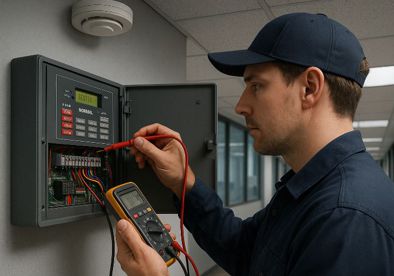Repair of automatic fire alarm system

Repair of an automatic fire alarm system at a facility begins with diagnostics, as it is impossible to properly restore functionality without identifying the cause of the malfunction. In a warehouse, office, or industrial building, a range of typical issues may occur: damaged communication lines during renovations, sensor failure due to contamination or aging, malfunctions in control units caused by power surges. Common causes also include moisture ingress, contact corrosion, poor-quality installation, or natural wear of equipment.
During repair, technicians check all signal loops, cable conditions, connection integrity, and the settings of control units. Diagnostics involve the use of special testers and measuring devices to detect breaks, short circuits, and hidden faults that may not be visible. Even when the problem seems localized—for example, a single non-functioning detector—the entire signal line is inspected to avoid recurring issues later.
The repair process includes replacing faulty components: smoke or heat detectors, manual call points, power and control modules, alarm sounders, and visual indicators. If cables are damaged, the affected sections are replaced in accordance with fire safety regulations and proper installation standards. It is also essential to restore the sealing of enclosures and protect connections from moisture and dust to prevent future breakdowns.
Once all components are replaced or restored, the entire system must be tested. Trial activations are carried out using simulated smoke or heat, the transmission of alarm signals to monitoring stations or the fire department is checked, and the proper operation of sounders and visual alerts is verified. If necessary, software settings are adjusted, and control unit parameters are updated to ensure correct coordination between detection and alert zones.
All repair work must be carried out by organizations licensed to service fire protection systems. This legal requirement ensures the use of certified equipment and compliance with regulations during system restoration. Unauthorized or unqualified work can lead not only to further failures but also to real danger during a fire due to delayed detection or inactive alerts.
Property owners and tenants are responsible for maintaining fire alarm systems in proper working condition. This is not just a formality, but a crucial element in protecting lives, safeguarding inventory, and ensuring business continuity. While regular maintenance minimizes breakdowns, any malfunctions must be addressed promptly. Timely repairs help prevent serious consequences and fines from supervisory authorities.
When planning repairs, it’s important to consider not only the urgency of fixing current issues but also the overall condition of the system. If the equipment is significantly worn or the building’s layout has changed, upgrades or partial replacement with modern, more reliable components may be necessary. A comprehensive approach allows not only for fixing existing faults but also for improving system reliability in the long term.